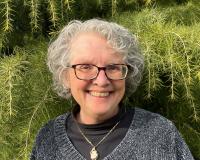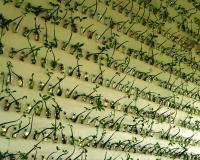
Vibrant Environment
All
All | Biodiversity | Climate Change and Sustainability | Environmental Justice | Governance and Rule of Law | Land Use and Natural Resources | Oceans and Coasts | Pollution Control

As we celebrate National Wetlands Month in May, one of the Washington State Department of Ecology’s best and brightest—and a longtime “hero” of Washington State’s wetlands—Lauren Driscoll has been recognized for her lifetime of wetlands program development work by ELI.

As we celebrate National Wetlands Month in May, one of the Washington State Department of Ecology’s best and brightest—and a longtime “hero” of Washington State’s wetlands—Lauren Driscoll has been recognized for her lifetime of wetlands program development work by ELI.

I was introduced to mangroves early in my childhood during family trips to Bear Cut in Key Biscayne, Florida—the same plants that grew in my family’s hometown on the northern coast of Cuba. In 2003, I first used mangrove imagery in my artwork as a metaphor for the immigrant. I imagined the mangrove propagules floating along the water and setting root on a sandbar. Little by little they would grow alongside each other, capture sediment, create land, and build new habitats. Like immigrants in a community who come together to support one another, the roots of each mangrove tree come together to create a formidable structure that protects against the dangers of storm surge.

I was introduced to mangroves early in my childhood during family trips to Bear Cut in Key Biscayne, Florida—the same plants that grew in my family’s hometown on the northern coast of Cuba. In 2003, I first used mangrove imagery in my artwork as a metaphor for the immigrant. I imagined the mangrove propagules floating along the water and setting root on a sandbar. Little by little they would grow alongside each other, capture sediment, create land, and build new habitats. Like immigrants in a community who come together to support one another, the roots of each mangrove tree come together to create a formidable structure that protects against the dangers of storm surge.

I was introduced to mangroves early in my childhood during family trips to Bear Cut in Key Biscayne, Florida—the same plants that grew in my family’s hometown on the northern coast of Cuba. In 2003, I first used mangrove imagery in my artwork as a metaphor for the immigrant. I imagined the mangrove propagules floating along the water and setting root on a sandbar. Little by little they would grow alongside each other, capture sediment, create land, and build new habitats. Like immigrants in a community who come together to support one another, the roots of each mangrove tree come together to create a formidable structure that protects against the dangers of storm surge.

I was introduced to mangroves early in my childhood during family trips to Bear Cut in Key Biscayne, Florida—the same plants that grew in my family’s hometown on the northern coast of Cuba. In 2003, I first used mangrove imagery in my artwork as a metaphor for the immigrant. I imagined the mangrove propagules floating along the water and setting root on a sandbar. Little by little they would grow alongside each other, capture sediment, create land, and build new habitats. Like immigrants in a community who come together to support one another, the roots of each mangrove tree come together to create a formidable structure that protects against the dangers of storm surge.

The coronavirus pandemic has focused increased attention on indoor air quality and ventilation. Yet, many people remain unaware of the health risks posed by an activity that occurs every day in their homes: cooking.

The coronavirus pandemic has focused increased attention on indoor air quality and ventilation. Yet, many people remain unaware of the health risks posed by an activity that occurs every day in their homes: cooking.

Climate change and environmental degradation not only pose visible threats to the well-being of millions today, but also present hazards to future generations—challenging the principle of intergenerational equity. Intergenerational equity, a concept that calls for fairness and justice between generations, requires that past, present, and future generations share the Earth’s resources in a fair and equitable manner. Related to this is the concept of intergenerational well-being, which calls on present generations to live and govern in a way that will allow future generations to live healthy and complete lives.

Climate change and environmental degradation not only pose visible threats to the well-being of millions today, but also present hazards to future generations—challenging the principle of intergenerational equity. Intergenerational equity, a concept that calls for fairness and justice between generations, requires that past, present, and future generations share the Earth’s resources in a fair and equitable manner. Related to this is the concept of intergenerational well-being, which calls on present generations to live and govern in a way that will allow future generations to live healthy and complete lives.